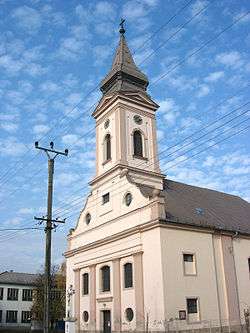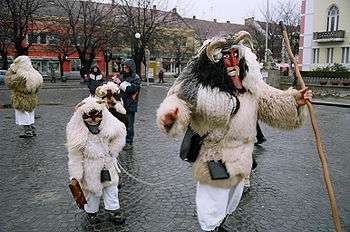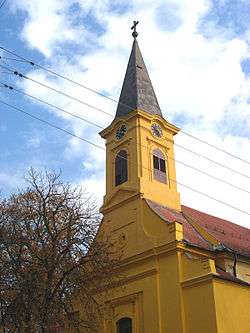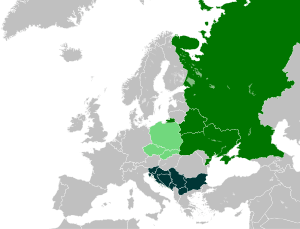Šokci
| Total population | |
|---|---|
| (Unknown, see text) | |
| Regions with significant populations | |
|
| |
| Languages | |
| Croatian and Hungarian | |
| Religion | |
| Roman Catholicism | |
| Related ethnic groups | |
| Bunjevci, Croats and Serbs |
Šokci (Croatian: Šokci, Hungarian: Sokácok, Serbian: Шокци / Šokci) are an ethnographic group of South Slavs mainly identified as Croats. They are not considered a separate ethnicity in Croatia[1] and elsewhere, while in Serbia they are recorded as an ethnic group in censuses per self-declaration. They live in various settlements along the Danube and Sava rivers in the historic regions of Slavonia, Baranya, Syrmia and western Bačka. These regions today span eastern Croatia, southeastern Hungary, and northern Serbia. Šokci are considered natives in Slavonia and Syrmia in Croatia.
Population
Šokci are considered to be a native population of Slavonia and Syrmia in Croatia.[2] The Croatian Bureau of Statistics does not record the Šokci as a separate narodnost (2001).[1] According to the 2011 census in Serbia, 607 people declared as ethnic Šokci.[3] Outside of Slavonia and Syrmia, they live in the settlements of Bački Monoštor, Sonta, Sombor, Bački Breg in Bačka, Serbia, and Hercegszántó in Hungary.
Ethnonym
There are several hypotheses on the origin of the name Šokci-Šokac.
- Serbo-Croatian word skok or uskok ("to jump, leap, to jump in"), derived from "the Catholics who abandoned the Orthodox Church".[4]
- Folk etymology derives it from šaka ("fist"), from the way they make the sign of the cross, different from the other Catholics who sign with an open hand.[4]
- Italian word sciocco [ˈʃɔkko] ("frenzied, insane").[4]
- V. Skarić (1932) theorized that it was derived from German der Sachse ("Saxon", sh. Sas).[5]
- F. Kluge (1924) derived it from German schock, "a detachment of 60 men", which was the size of historical border patrols on the Sava.[5]
- Matija Petar Katančić (1750–1825), the first to theorize on the name,[5] connected the ethnonym with the toponym of Succi or Succus in Thrace, found in the work of Ammianus Marcellinus (fl. 353–378).[6]
- Eastern Slavonia and western Syrmia in Croatia is often referred to as Šokadija ("land of the Šokci"),[2] although the term is not geographically limited, it is rather a general moniker for the Šokac "ancestral land".[7]
Origin
The origin of Šokci people is not completely clear.
- The prevalent opinion of modern scholars, based on etymology, is that they were Catholics who moved from the south, across the Sava from Bosnia, by the end of the Ottoman wars in Europe, as the Ottomans were retreating.[7] The Šokci in Baranja are considered to be descendants of settlers from a mass migration of Croats from an area near Srebrenica, Bosnia into the region after the Ottoman retreat in the 18th century.[8] Regardless of when exactly they settled there, Šokci are considered to be an indigenous Croatian population of Slavonia and Vojvodina, which distinguishes them from the majority of the present-day population of these regions who are descendants of later settlers. The feeling of being indigenous rather than a settler is an important characteristic of the population.[7]
The Serbian Orthodox Church historically regarded the population as "Serbs of Roman Catholic faith".[9]
History
17th century
The earliest known Ottoman Turkish defter that mentions the Šokci dates from 1615, a ferman by sultan Ahmed I, dated Safer 9, 1024 according to the Islamic calendar, in which he referred to them as the population of the "Latin faith" whose "religion is completely different from the faith of the Serbs, Greeks and Vlachs". They are also mentioned in the documents of the Roman Catholic Church where they requested Jeronim Lučić to become the bishop of Bosnia and Slavonia in 1635, and in one writing from the time when Eugene of Savoy invaded Ottoman territory down to Sarajevo in 1697.
18th century
In the 1702 census of Đakovo, one of the cities that was retaken from the Ottoman Empire following the Treaty of Karlowitz, there were 500-600 inhabitants described as Catholic Slav/Slavonian (Latin: Slavi catholicae fidae).[10] Tadija Smičiklas later republished the same census and used the terms "Slovinci" and/or "Šokci", and claimed 400 inhabitants.[10] According to the contemporary Antun Kanižlić (1699–1766), the term Šokci was a slang reference to Catholic Slavonians that was used by the Orthodox.[10]
According to the Austrian census in Bačka from 1715, Serbs, Bunjevci, and Šokci comprised 97.6% of population.[11] The 1720 census in Bačka recorded 72% Serbs and 22% Bunjevci and Šokci.[12] After the Treaty of Passarowitz (1718), the first Habsburg census recorded in Banat about 20,000 citizens, mostly Serbs.[13]
19th century
In the old Austro-Hungarian censuses there was large number of Šokci, both in Croatia/Slavonia and in Vojvodina. According to the 1840 data, the population of Croatia and Slavonia numbered 1,605,730 people, of which 777,880 (48%) were Croats, 504,179 (32%) Serbs, and 297,747 (19%) Šokci. The Šokci were concentrated in the Požega, Virovitica, and Syrmia counties, and in the Slavonian Military Frontier.
20th century
According to the 1910 census in Austria-Hungary, there were 88,209 Bunjevci and Šokci in the Hungarian part.[14]
Contemporary

Šokci living in Croatia and Hungary, as well as many of those living in Serbia, today usually consider themselves to be a subgroup of Croats. In Serbia, Šokci and Bunjevci have been recorded as a separate "modality" or national or ethnic affiliation by the national census in 1991 and 2002.[15] Unlike Bunjevci, the other Catholic Slavic group from the same area, Šokci mostly declare themselves as Croats rather than the separate group, and some have also declared themselves Yugoslavs in the census. In the 1991 census, there were 1,922 declared Šokci in what has later become Federal Republic of Yugoslavia, and a much larger number of Croats. The population that declared "Šokci" as an ethnicity in the 2002 census is small and appears in summary lists under "Other", while there were over 70,000 declared Croats.[16] The choice of ethnicity between "Šokac" and "Croat" that is promoted in Serbia is described by scholars in Croatia as bizarre and harmful, because it exacerbates the Šokac myths of independence and antiquity, puts them into the realm of political folklore and helps provoke various 19th-century conflicts between the Croats and the Serbs.[17]
In general, the number and the percentage of the Šokci has decreased because of an unwritten policy that each family should have only one child, because they did not wish to divide their estate and other riches in each following generation. Unfortunately such a practice worked up until the 19th/20th century, at which point they were practically overwhelmed in number by the immigrants which had a much larger reproduction rate (certainly over two children per family at the time).
Villages with numerous Šokac population in the region of Bačka are: Sonta (Apatin municipality), Bački Breg and Bački Monoštor (Sombor municipality). In 2002 census in Serbia, most of the inhabitants of these villages declared themselves as Croats.
Most of the Hungarian Šokci live in the Baranya region, particularly in the town of Mohács.
Religion

The Šokci are Roman Catholic by faith and follow the Latin Rite.
Language
The Šokci speak an old-Shtokavian Slavonian sub-dialect that is almost exclusively spoken by Šokci and closely related to Bunjevac dialect. The Slavonian dialect has a mixed Ikavian and Ekavian accent: Ikavian is predominant in Posavina, Baranja, Bačka and in the Slavonian sub-dialect enclave of Derventa; and Ekavian in Podravina. There are also enclaves of one accent in the territory of the other, and also of mixed Ekavian–Ikavian and Jekavian–Ikavian accents. In some villages in Hungary, the original Slavic yat sound is preserved.
Culture


Traditions
Many of the traditions of the Šokci are influenced by their environment - they live in the fertile Pannonian plain where they cultivate grains and corn in large fields surrounding their villages. The villages often have one main street (šor) where each subsequent family house has auxiliary buildings and a spacious yard, as well as a water well. The central street is surrounded on both sides by water channels, which have small crossings in order for one to reach the house.
Families often keep poultry, particularly ducks and geese, although the main source of meat are the pigs, which are almost inevitably kept by a Šokac. They enjoy pork-based products such as ham, sausages (particularly kulen) and bacon. These products are customarily obtained by the traditional autumn slaughtering. The most common fruit are plums, not least because it is often fermented into liquor called rakija.
The abundance in which they have traditionally lived has made the Šokci a naturally merry people, who pay a lot of attention to folklore. Each Šokac village inevitably has a cultural society where they cultivate their folk songs and dances. A popular folk custom is the bećarac. They also hold a yearly festivity called the "Šokačko sijelo", held over a nine-day period in February, being the largest traditional event in the area of Posavina near Županja, featuring local culture and traditions.
Music
The most recognisable feature of Šokci culture is their music which is played mostly on the tambura instrument. Many tambura bands achieved nationwide fame in Croatia. The body of the tambura was traditionally made of the wood of maple, poplar or plum trees, while today it's mostly made of spruce or fir trees. Another instruments used in the past was the bagpipe. The traditional wedding festivities are paid much attention to, sometimes even catching the attention of entire villages.
Folk costumes
The traditional outfit of the Šokci, called the rubina, is made of white linen cloth with lace decorations, and the main part of it is a blouse called oplećak i krila. The women mostly wear the entire outfit only in the summer, replacing it with a wool skirt in the winter. The most esteemed decoration of a Šokac outfit are the gold coins known as dukati (ducats). A rich Šokac girl would have a large number of dukati weaved onto her chest not only as a decoration but as a clear sign that she comes from a wealthy family.
Prominent individuals
- Josip Šokčević, Croatian ban, born in Vinkovci
- Mara Švel-Gamiršek, Croatian writer
- Matija Antun Relković, Croatian writer, born in Davor
- Julijana Matanović, Croatian writer
- Josip Kozarac, Croatian writer, born in Vinkovci
- Ivan Kozarac, Croatian writer, born in Vinkovci
- Ilija Okrugić, Croatian writer, born in Sremski Karlovci
- Martin Novoselac, Croatian football player and coach, born in Vinkovci
- Ivica Olić,[18] Croatian professional footballer, born in Davor
- Ivan Rakitić,[19] Croatian professional footballer, father from Sikirevci
- Goran Vlaović, Croatian professional footballer, born in Nova Gradiška
- Fabijan Šovagović, Croatian actor, born in Ladimirevci
- Flórián Albert, Hungarian football player, European Footballer of the Year in 1967, born in Hercegszántó[20]
- Mario Mandžukić,[18] Croatian professional footballer, born in Slavonski Brod
Gallery
-

Šokac wine cellars in Draž, Croatia
-

Catholic Church in the Šokac village of Bački Monoštor, Serbia
-

Catholic Church in the Šokac village of Bački Breg, Serbia
See also
| Part of a series on |
| Croats |
|---|
 |
|
Subgroups |
| Wikimedia Commons has media related to Šokci. |
References
- 1 2 Croatian 2001 census, detailed classification by nationality
- 1 2 Ljubica Gligorević (2004). "Etnološke znakovitosti". Vukovarsko-srijemska županija (special ed.). SN Privlačica Vinkovci / Vukovar-Srijem County. pp. 60–69. Retrieved 2012-02-14.
- ↑ Попис становништва, домаћинстава и станова 2011. у Републици Србији: Становништво према националној припадности - „Oстали“ етничке заједнице са мање од 2000 припадника и двојако изјашњени
- 1 2 3 International Society for Ethnology and Folklore. International Congress (2004). Times, Places, Passages: Ethnological Approaches in the New Millennium. Akadémiai Kiadó. p. 115. ISBN 978-963-05-7919-3.
- 1 2 3 Proceedings for social sciences. 47. Matica srpska. 1967. pp. 135–137.
- ↑ Matija Petar Katančić (1798). De Istro ejusque adcolis commentatio in qua autochthones illyrii ex genere Thracio advenae item apud illyrios a primis rerum publicarum temporibus ad nostram usque aetatem praesertim quod originem, linguam et literaturam eorumdem spectat deducuntur, aucto. typis Universitatis Pestinensis. pp. 109–.
- 1 2 3 Pšihistal, 2011, pp. 86–88
- ↑ Hadžihusejnović-Valašek, 1993, p. 182
- ↑ Srpska pravoslavna mitropolija karlovačka: po podacima od 1905. Saborski odbor. 1910. p. 474.
Под именом Буњевци и Шокци разумемо Србе римок
- 1 2 3 Fine, 2006, p. 481
- ↑ http://hic.hr/books/seeurope/011e-bognar.htm
- ↑ Jovan Pejin, Velikomađarski kapric, Zrenjanin, 2007, page 28.
- ↑ Milan Tutorov, Banatska rapsodija, Novi Sad, 2001, page 261.
- ↑ Charles W. Ingrao; Franz A. J. Szabo (2008). The Germans and the East. Purdue University Press. pp. 173–. ISBN 978-1-55753-443-9.
- ↑ "Methodological explanations" (ZIP/PDF). 2002 Census of Population, Households and Dwellings. Statistical Office of the Republic of Serbia. May 2003. p. 8. Retrieved 2012-02-14.
- ↑ "Final Results of the Census 2002" (PDF). Republic of Serbia - Republic Statistical Office. 2002-12-24. Retrieved 2012-02-14.
- ↑ Pšihistal, 2011, p. 105
- 1 2 "Olić za petak najavio svoj klasični angažman: 'Prolit ću znoja i za pet utakmica!'" (in Croatian). Zagreb: Jutarnji.hr.
- ↑ "IVAN RAKITIĆ OTKRIO ŽIDAKU 'Igram najbolje u karijeri jer sam uz Raquel najsretniji u životu'" (in Croatian). Zagreb: Jutarnji.hr.
U mojem selu, u Sikirevcima, ima mnoštvo Rakitića, ali samo jedan mi je rođak. A svi se zovu Ivan Rakitić. Šokci smo sto posto...
- ↑ (Croatian) Hrvatski glasnik br.33/2007. Počasni građanin Santova, 16 August 2007, p. 5
Sources
- Ante Sekulić (1989). Bački Bunjevci i Šokci. Školska knj. ISBN 978-86-03-99172-7.
- Ivan Ivanić (1899). Bunjevci i Šokci u Bačkoj, Baranji i Lici. Dr. Dimitrijević.
- Ružica Pšihistal; Faculty of Philosophy, University of Josip Juraj Strossmayer in Osijek (June 2011). "The Ethnomyth of Šokci". Narodna umjetnost: Croatian Journal of Ethnology and Folklore Research. Zagreb, Croatia: Institute of Ethonology and Folklore Research. 48 (1). ISSN 0547-2504. Retrieved 2012-02-14.
- Hadžihusejnović-Valašek, Miroslava (March 1993). "Baranja je "tvrd orah". Analiza istraživanja i popularizacije tradicijske baranjske folklorne glazbe" [Baranja is "tough nut". Records and popularisation analysis of traditional Baranja folk music] (PDF). Studia ethnologica Croatica (in Croatian). Department of Ethnology and Cultural Anthropology, Faculty of Humanities and Social Sciences, University of Zagreb. 4 (1). ISSN 1330-3627. Retrieved 2012-02-12.
- John Van Antwerp Fine (2006). When ethnicity did not matter in the Balkans: a study of identity in pre-nationalist Croatia, Dalmatia, and Slavonia in the medieval and early-modern periods. University of Michigan Press. ISBN 978-0-472-11414-6.
- (Serbian) Mile Nedeljković: Leksikon naroda sveta, Beograd, 2001.
- (Croatian) Tko su Šokci? (Who are the Šokci?)
- (Croatian) O porijeklu Šokaca, iz knjige "Zagrebačka Šokadija" (On the origin of Šokci, from the book "Šokadija of Zagreb")
- (Serbian) "KOLIKO SE POZNAJEMO?" - brochure of the Vojvodina project "AFIRMACIJA MULTIKULTURALIZMA I TOLERANCIJE U VOJVODINI"

